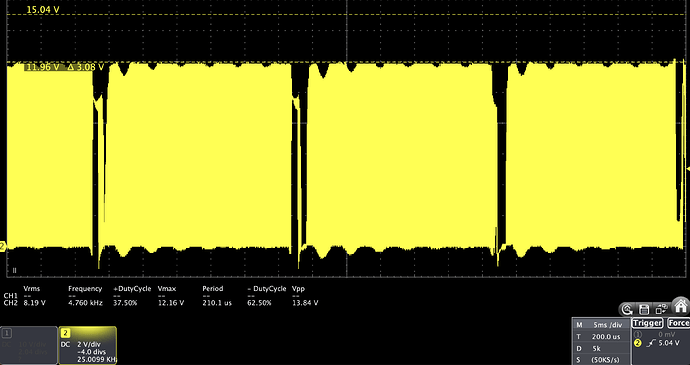I am currently using the B-G431-ESC1 to drive a sensorless BLDC motor. I have the motor running well in an velocity open loop, but I need to run the motor in a closed loop. From my understanding I need to use BEMF as feedback but don’t know how to actually get the BEMF values and then what to do with those values afterwards. Is there a different way to do a sensorless closed velocity loop? Does anyone have any pointers as to how to get the BEMF values and what to do with them afterwards?
I have attempted to configure the ADC using the STM32 library but was unsuccessful. If that is the path to take are there any pointers there?
This is my current code:
#include <Arduino.h>
#include <SimpleFOC.h>
#include <string>
#include "stm32g4xx_hal.h"
//local variable definitions
float target = 0.0; // used to change currently tested variable
int spinIt = 1; // iterator for the startup
int spinItSpeed = 1500; // rate of the startup, higher = slower
float radPerSec = 0; // driver the motor speed
int mxRads = 0; // max motor speed
int outIt = 0; //used for communication rate iteration
//Set up the motor and driver, motor is 7 pp, .12 phase resistor, and 1400KV
BLDCMotor motor = BLDCMotor(7, .12, 1400);
BLDCDriver6PWM driver = BLDCDriver6PWM(A_PHASE_UH, A_PHASE_UL, A_PHASE_VH, A_PHASE_VL, A_PHASE_WH, A_PHASE_WL);
/*controls the motor using the UART.
-g starts the motor and revs up to 300 rad/s,
-s stops the motor,
-and entering a number sets the P in pid to that number
-(currently not useful, but implemented for later tuning)
*/
void serialControl(){
static String received_chars;
while (Serial.available())
{
char inChar = (char)Serial.read();
received_chars += inChar;
if (inChar == '\n')
{
float num = received_chars.toFloat();
if(received_chars == "s\n"){
radPerSec = 0;
mxRads = 0;
received_chars = "";
Serial.println("Stopping Motor.");
break;
}
else if(received_chars == "g\n"){
radPerSec = 0;
mxRads = 300;
received_chars = "";
Serial.println("Starting Motor.");
break;
}
else{
target = num;
Serial.print("PID.P = ");
Serial.println(target);
received_chars = "";
}
}
}
}
void setup()
{
//initializes the psu and driver
driver.voltage_power_supply = 14.8;
driver.init();
motor.linkDriver(&driver);
motor.voltage_limit = 14.8;
motor.velocity_limit = 2212;
//Sets up openloop FOC
motor.controller = MotionControlType::velocity_openloop;
// set FOC modulation type to sinusoidal
motor.foc_modulation = FOCModulationType::SinePWM;
motor.init();
motor.initFOC();
Serial.begin(115200);
delay(1000);
}
void loop()
{
//starts the motor moving at radPerSec
motor.loopFOC();
motor.move(radPerSec);
//this loop controls the rate at which the motor speeds up
if (spinIt%spinItSpeed == 0 && radPerSec<mxRads){
radPerSec++;
spinIt = 1;
}
else{
spinIt++;
}
//motor.PID_velocity.P = target;
serialControl();
}

